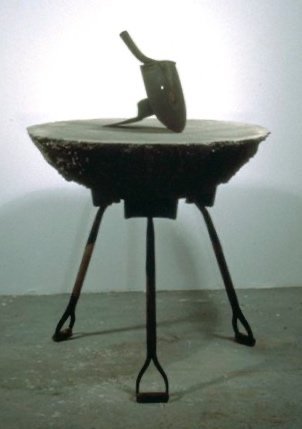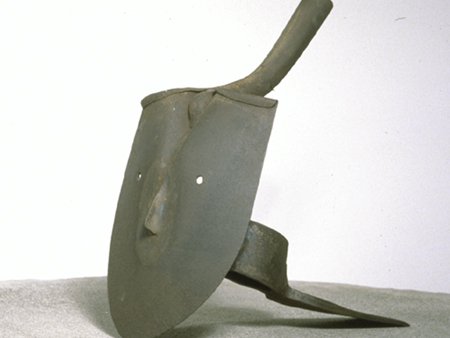Work Table with Work
concrete, steel, wood
5' x 5' x 5'
1983
A work of art on a pedestal is the paradigmatic presentation form for smaller cultural artifacts.
A mound of wet concrete, abandoned by workers done for the day, is stuck with three shovels. The left-over concrete, surplus to a project, sets up. When it kicks off, the conglomerate mass hardens the shovels in place. The irreversible process of solidification, once it begins within an hour or so of mixing, renders the concrete useless for further construction purposes; its pourable matrix is only purposeful within the time-frame of its fluid state. This mutable feature of concrete gives it its terrific utility as a building material, but also means that waste is inevitable; the world is filled with concrete set before its time. One purpose for the material inverts into another; the endless potential of the mixed concrete becomes fixed in the moment of its set with the timeless obduracy of stone. But here, the felicitous conjunction of shovels and concrete suggests a new purpose for this cast-off. Inverted, it becomes a three-legged stool, a new table for work, from work. One form of labour turns over into another.


An object sits on the table: a work of art on its pedestal. The head of a shovel, held upright by a mattock cutting through it, forms a mnemonic cycladic head, reminiscent of early modernism’s flirtations with the exotic and prehistoric – the origins of western figurative abstraction. Two holes in a rounded surface construe a mask: the object becomes a liminal portrait. Quintessential tools, the pick and the shovel, are now dysfunctionally conjoined. Here, labour’s pragmatic functions are turned over for other purposes. Tools fixed together without handles, steel without wood, show familial alignment with the shovels underneath.
The work that a work of art performs is categorically different from the work of the tool; yet their laboured relations are symbiotic, necessary and inevitable.
